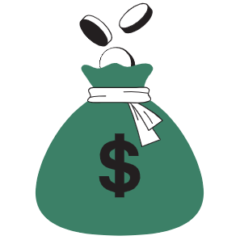Warren Buffett run Berkshire Hathaway paid a 10 cent dividend once in that one fateful year in 1967. Buffett, unarguably one of the best capital allocators ever, later joked that he must have been in the bathroom when that decision was made.
Because of all the ways a business returns profits back to its owners, dividend distribution is the least efficient. And here is why.
When a business earns a profit, it has decisions to make:
- Reinvest all of it back into the business.
- Reinvest some, return the rest in the form of dividends.
- Return all of it in the form of dividends.
The choice between the three will depend upon whether the business needs capital (money) to grow. And not just that, it needs to be able to deploy that precious capital at a respectable enough growth rate.
So, say that growth rate is 10 percent. Would you then want that business of which you are a shareholder of, to return some or all that profit back to you?
Probably not because now you will have to find an investible opportunity that is equal to or greater than that growth rate. There is hence that uncalled for reinvestment risk for you.
And if you own the shares in a non-tax favored account, you will be taxed on those dividends. So not only do you face reinvestment risk, but you’ll also incur a tax drag every time dividends hit your accounts.
But if reinvestment opportunities back into the business are limited, they (the folks running the business on your behalf) will have no choice but to return the profit to you and to the rest of the owners. The business at this stage is in a moderate growth phase and is generating more profit than it knows what to do with it.
And only when they have exhausted all possible avenues for reinvestment will they return all the profits to the owners. There is no more growth left. The business at this stage is a bond-like investment. And the bond market is not where you go looking to get rich.
All businesses go through these phases and when all is said and done, they either merge with other businesses or go extinct. That is capitalism.
But all businesses eventually must pay out all their profits, past and present, back to their owners in some form or the other. That is by design.
But when we focus exclusively on the kinds that pay dividends, we miss out on a big chunk of the still growing businesses. Nothing wrong with that but the long-range returns are unlikely to outpace the returns of a portfolio that owns all kinds of businesses.
And I’d especially be wary of businesses with unusually high dividend yields. Because there will be a catch. There will always be a catch.
But even with dividends, there is a much more efficient way that the likes of Buffetts practice to return profits back to the owners. And that is through share buybacks. And this is how it is done.
We first start with the market value of a business…
Market value of a business = Number of shares outstanding x Price per share
So, say a business has 1,000 shares outstanding in the marketplace today and each share trades at $1,000. The market value of that business then is 1,000 shares x $1,000 = $1,000,000.
Now say in a year, that business earns $100,000 in profits which the business for now retains on its books. So, with all things being equal, the value of that business should rise to $1,100,000. And the share price should now reflect the new value by rising to $1,100 per share.
But say the business as it stands today has no reinvestment opportunities left. It has hence no need to retain the profits that it earned.
The folks running the business on your behalf will then decide to issue the entire $100,000 profit in the form of a dividend. That would amount to $100 for each share you own.
The share price post dividend distribution reverts to the original $1,000 apiece. And you are then left with the tax consequences of that dividend hitting your accounts – whether you wanted it or not.
What could have been better? Buying back shares in the open market from the current owners and retiring them in earnest.
$100,000 buys ninety-one shares at the new share price of $1,100 and once that is executed and the shares retired, there are now 909 shares outstanding with each share trading at $1,100 apiece. The total value of the business post-share buyback reverts to $1,000,000 (909 shares x $1,100 share price).
But even though the total value of the business did not change, your stake in that business grew by 11 percent.
Or to put it another way, the value of your shares increased by 11 percent. And with no tax consequences for you at that.
You now get to decide when you want to take distributions by selling shares at your convenience instead of being forced to accept distributions on a preset basis in the form of dividends. That is what you want. That is what most people in the know would want.
So dividends are nice but they should not be your only focus when designing an efficient and a long-term sustainable pension plan.
Thank you for your time.
Cover image credit – Ibrahim, Pexels

